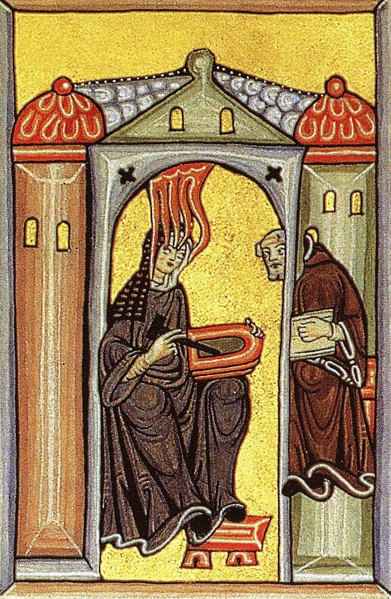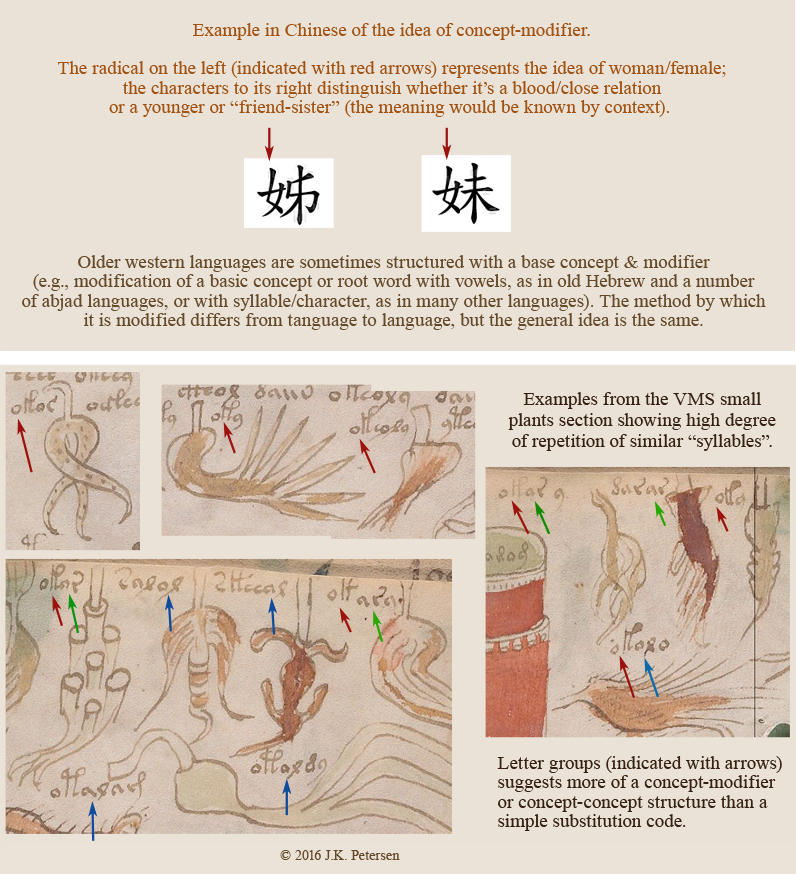6 May 2017
A discussion about the Voynich Manuscript zodiac pages (with examples by Marco Ponzi) came up today on the Voynich.ninja forum and I wanted to post something I’ve been sitting on for a while that relates to the structure of the VMS text.
I’ve selected some of the imagery from one of the small-plant pages and included an example from Chinese. This does not mean the underlying language is Chinese but that the structure of the VMS text is similar to quite a number of languages that have a syllabic structure that is based on concept-modifier or concept-concept in various combinations of simple building blocks. I think this structure argues against a basic substitution code but might enlighten how the manuscript is encoded.
If you look at various sections of the manuscript, you will see the same patterns. The VMS is written mostly in Latin characters and numerals (with some original shapes included), but the conceptual foundation (that of basic building blocks combined in similar ways for similar items), exhibits some of the structural characteristics of syllabic languages (or of a constructed/synthetic language).
 Constructed languages were not a novel idea in the middle ages. Magical languages have a long history, as do kabbalistic symbols as a means of communication. There are some interesting arguments that much of the Bible is allegorical and that there are numbers embedded in the text that provide secret information to those who are schooled in the hidden arts. Hildegard von Bingen created a cipher and partly constructed language in the 12th century.
Constructed languages were not a novel idea in the middle ages. Magical languages have a long history, as do kabbalistic symbols as a means of communication. There are some interesting arguments that much of the Bible is allegorical and that there are numbers embedded in the text that provide secret information to those who are schooled in the hidden arts. Hildegard von Bingen created a cipher and partly constructed language in the 12th century.
In the 17th century, John Dee had a strong interest in ciphers, symbols, and magical languages and expended considerable energy on recording them, and Athanasius Kircher developed a universal script in the hopes that communication could reach a wider audience.
But coming back to the Voynich Manuscript…
The VMS has many properties that suggest a constructed language or perhaps one that is a hybrid of natural and constructed language. I’ve remarked before on its singularly regimented style and seeming rigidity and its similarity to syllabic languages (anyone who has practiced their ba, be, bo, bu, and ma, me, mo, mu while studying Asian languages knows what I’m talking about).
The likelihood that the labels are names or regular nouns (as opposed to combinations of noun-concepts) seems low, given that no one has managed to decode them in a way that relates to the labels as a whole or illuminates any of the rest of the text. Anagramming the characters to come up with a handful of labels that look like words isn’t sufficiently convincing either. It seems more likely that the labels represent attributes or information about the items’ composition or use than the names of the items.
Will this unlock the information on the pages without illustrations?
The structure of the “labels” is similar to that of the main text, which also appears to be made up of simple building blocks and includes a high degree of repetition, but there are some additional dynamics in the longer passages that go beyond the kind of glyph-combinations that are in the labels. The very fact that many lines end with the same characters, characters that rarely appear midline, suggests an added level of complexity. Nevertheless, a better understanding of the labels might help unlock the rest.
J.K. Petersen
© Copyright 2016 J.K. Petersen, All Rights Reserved


J.K.,
I wish Jorge Stolfi could see how many people in recent years are following his lead and recognising how the Voynich text does conform to the model he reached through his linguistic analyses. For some time after he gave it as his opinion that the language might be Jurchen, people refused to take his results into account – and rather worse.
In the same way, I think it was William Friedman and/or John Tiltman (it will be in d’Imperio’s Elegant Enigma, published in the 1970s) who first suggested an artificial language rather than a cipher.
Who first mentioned Hildegarde would surely be glad to see how often that idea has been given sober consideration too, but the idea tends soon to be dropped because the manuscript doesn’t really show anything very close to her pictures.
But it’s great to see people re-considering possibilities, rather than running blinkered after some notion on which their minds are already fixed.
I think we owe Don Hoffman too, because no-one had paid any more attention to the ‘core-mantle-crust’ model developed by Stolfi until Don did the work of showing how well it suits the text. Whether or not you agree with Don’s translations, the model itself surely works.
Thank you, Diane.
The latest version of my paper showing my ideas about how the words seem to have been constructed using smaller parts (and can be deconstructed when followed in reverse), with a list of the 2,300+ (deconstructed) words repeated two or more times in the VMS, is at:
https://www.academia.edu/s/40eb83947a/voynich-manuscript-solution-proposed-the-glyph-characters-and-words-in-the-manuscript-updated-20sep19
Support for my plant identifications with mnemonic devices found in the VMS images may be found at:
https://www.academia.edu/s/c9b1bf0bbc/voynich-manuscript-solution-proposed-the-mnemonic-and-other-devices-found-in-plant-images-in-the-voynich-manuscript-images
Additional Scorpio images without the normal number of legs are shown at:
https://www.academia.edu/s/e81f9ba9de/strange-scorpios-4nov19
I invite comments, suggestions, additional info/images, refutations, corrections, arguments and so on.
You seem to think I am going down the same road as my predecessors, but if Stolfi felt that the VMS was linguistic, then he and I probably don’t see the text in the same way, and I’m not completely sure it’s an artificial language either, so Friedman and I may have a different perspective, as well. The VMS text could be artificial without necessarily being a language.
Also, I am not giving “sober consideration” to Hildegarde’s “idea”, in the way that you are implying. I am familiar with her combination of cipher + constructed language + lookup and I think it’s a good idea for anyone studying the VMS to be aware of her work, especially since it was such a creative approach for such an early system, but I am not convinced the VMS is structured the same way.
So it may be misleading to characterize my work as “reconsidering possibilities” as though I am simply re-treading the same historical road. I think I have a different view of the VMS text than my predecessors, but it may take a number of articles to be able to fully describe it.